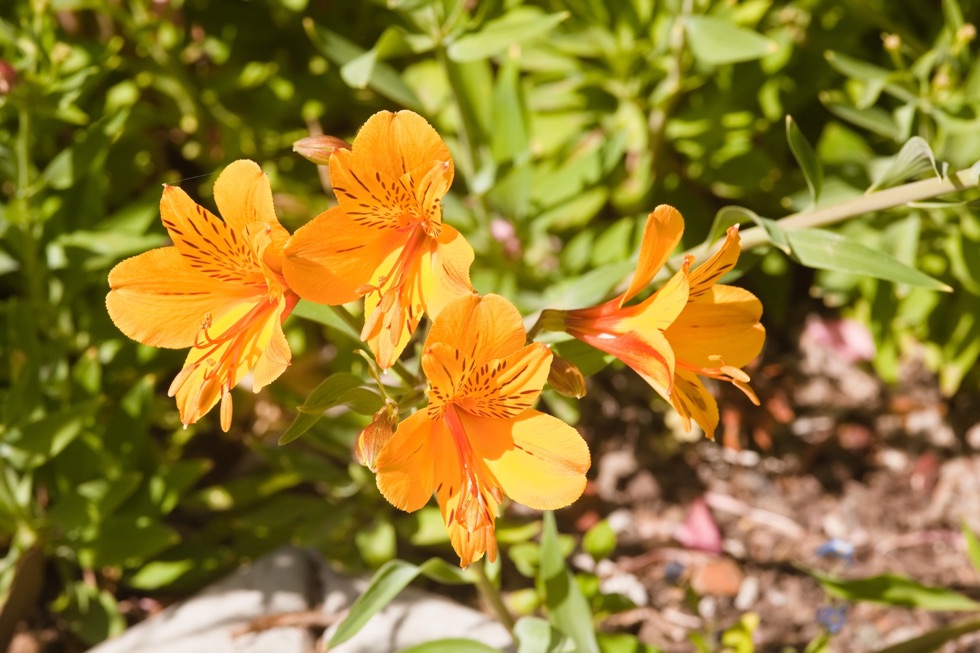PERENNIALS > ALSTROEMERIA > CONTAINERS

Elizabeth is a Permaculture Garden Designer, Sustainability Consultant and Professional Writer, working as an advocate for positive change. She graduated from the University of St. Andrews with an MA in English and Philosophy and obtained a Diploma in Applied Permaculture Design from the Permaculture Association.
Reviewed By COLIN SKELLY

Colin is a Horticulturist and Horticultural Consultant with experience in a range of practical and managerial roles across heritage, commercial and public horticulture. He holds the Royal Horticultural Society’s Master of Horticulture award and has a particular interest in horticultural ecology and naturalistic planting for habitat and climate resilience.
IN THIS GUIDE
ALSTROEMERIA GUIDES
Container Growing
Deadheading
Division
Problems
Varieties
Winter Care
Peruvian lilies, also known as Alstroemeria, are vibrant and exotic-looking perennials which can work very well in containers.
Growing Alstroemerias in containers can be a great idea, but it is important to understand the care and conditions that these South American plants require.
You’ll need to provide those conditions and care so that the plants flower well and remain happy and healthy.
Can You Grow Alstroemeria In Pots?

Yes, these plants can be a good choice for container growing and they can thrive in suitable pots.
However, it is worth noting that although these plants can sometimes survive a winter in the ground, container-grown plants will need to be taken under cover during the winter months.
Most Alstroemerias are H4 hardy, which means that they can be damaged in more extreme winters and when grown in chillier or more exposed parts of the UK.

Plants in containers are more vulnerable to cold because they do not have the protection of the ground around them, and bulb-like tubers are more likely to be impacted.
High winter rainfall can also cause problems with saturation and waterlogging.
To combat this, you will need to have a cool porch or unheated greenhouse in which to place them to keep them protected from the effects of frost.

Smaller, shorter Alstroemeria are usually a better choice for container growing.
Make sure you understand how tall the cultivar you are considering will ultimately grow.
Height is one of the key considerations when choosing Alstroemeria, especially when you plan to grow them in containers.
Choosing A Container

When choosing a container for Alstroemeria, it is important to note that they require free draining conditions.
Any container that you choose should allow for the free drainage of excess water through the base.
Alstroemeria does best when their roots are given the opportunity to spread.
A container of at least 40cm in diameter should usually be selected for mature plants, but for smaller specimens, be sure not to over-pot, as this can cause waterlogging.
Choose a container slightly larger than the existing root system then pot up as the plant grows, choosing a slightly larger container each time.
While there are a number of different containers that you could choose, terracotta pots are sturdy yet have some porosity and will complement the vibrant hues of the flowers.
Choosing A Compost Or Potting Mix

Fill your chosen container with a good quality, peat-free soil-based compost with 20% grit added by volume to improve drainage.
“I use propagating bark to aid free drainage of growing media,” suggests Horticulturist Colin Skelly.
“[This] is also great for mulching the top of pots to retain moisture and keep down weeds.”
It can also be a good idea to add mulch over the top of the compost to retain moisture and to stop spot water from pooling on top of the growing medium.
Potting Up Alstroemeria

Alstroemeria is usually placed into containers (or into borders) in spring.
Plants will usually need to be repotted into a slightly larger container (or divided) every couple of years.
How Many Can You Plant Per Pot?
It is best to plant just a single Alstroemeria per container since they can clump out quite quickly.
However, remember that you can consider growing Alstroemeria in larger containers alongside other plants which like the same conditions, but will not be overly competitive.
Potted Alstroemeria Care
Alstroemeria, when provided with the right growing conditions, is pretty easy to care for.
You should be able to enjoy your plants over a number of years, as long as you care for them correctly.

Here are some things to look out for after you have planted your Alstroemerias in pots:
- Place pots in a sunny and sheltered position
- Water regularly during the growing season (remember that plants in containers will dry out more quickly – just make sure excess water can always drain away!)
- Feed container-grown Alstroemeria with a potassium-rich organic liquid plant feed (such as comfrey tea) from the arrival of the first buds right through the growing season
- Taller cultivars of Alstroemeria may need support – so place sticks, stakes or other appropriate support structures where these are required
- Protect younger plants from slugs and snails, which can sometimes be an issue
- When harvesting flowers for floral arrangements, or when deadheading, pull stems from the base rather than cutting, as this stimulates new growth
- Move your plants to a frost-free location such as a cool porch or unheated greenhouse for the winter months

